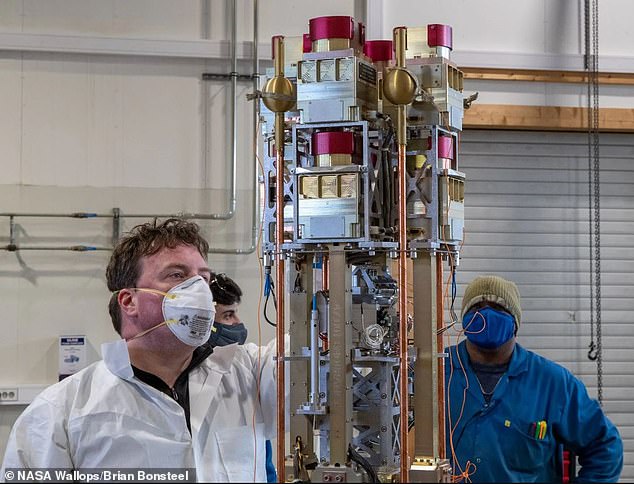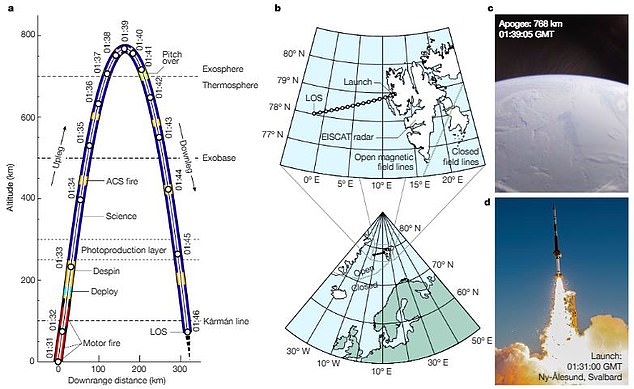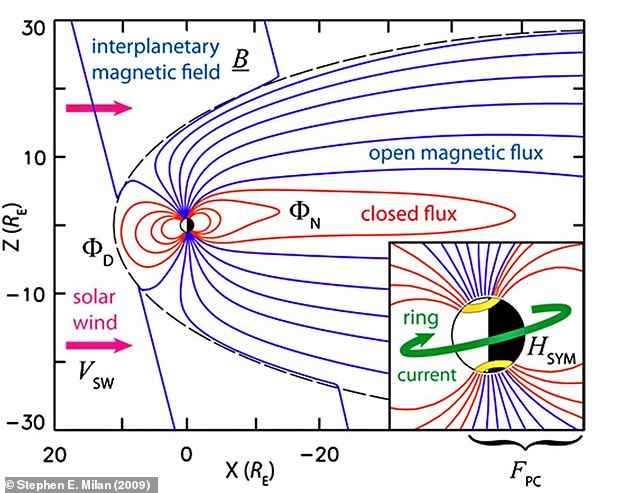Ever since Isaac Newton was hit by an apple in 1666, scientists have been trying to understand the forces that shape our planet.
Although Earth’s gravitational pull and magnetic field should be fairly familiar to us, scientists now say they have discovered a third field that is “just as fundamental.”
NASA researchers have found the first evidence of a subtle, nearly undetectable electric field surrounding the planet.
This “ambipolar electric field” could be responsible for the mysterious supersonic particle winds that constantly shoot out from Earth’s poles.
What’s more, researchers say the discovery could even help explain why life formed here on Earth and nowhere else.
NASA researchers have discovered a hidden energy field surrounding our planet that is “as important as gravity”

The field was discovered by launching the Endurance rocket (pictured) from the remote island of Svalbard.
In the 1960s, when the first spacecraft began to orbit the Earth, space agencies began to notice strange phenomena at the poles.
As the spacecraft passed overhead, they were hit by a sudden supersonic wind of charged particles erupting from the atmosphere.
But although scientists have known that these “polar winds” exist for more than 50 years, no one has yet been able to explain what causes them.
Some of the particles may simply be heated by unfiltered sunlight and escape as steam from a boiling pot.
But others were more mysterious, as scientists also found a steady stream of hydrogen ions that were completely cold, despite traveling at supersonic speeds.
Lead author Dr Glyn Collinson, of NASA’s Goddard Space Flight Centre, said: “Something had to be pulling these particles out of the atmosphere.”

Since the 1960s, scientists have known that there are streams of particles exiting the atmosphere at the poles, but only now do they have the technology (pictured) to detect the ambipolar electric field responsible for this.
The researchers hypothesized that the particles could be pulled out of the atmosphere by a planet-wide electrical charge somewhere about 250 kilometers above the surface.
At this altitude, the atoms in our atmosphere begin to disintegrate into negatively charged electrons and positively charged ions.
Since ions are 1,836 times heavier than electrons, they should sink toward Earth under the influence of gravity.
But because they have opposite charges, electrons and ions are held together by an electric field that attracts in both directions; hence the name ambipolar.
Like a dog pulling on a leash, electrons drag their ions upward against the force of gravity and lift them out of the atmosphere.
However, until very recently, the technology to measure this field simply did not exist.

Over the 518 kilometers traveled (illustrated on the left), the rocket detected an electrical potential difference of just half a volt. Although weak, this is exactly what scientists had predicted.
Beginning in 2016, researchers began developing a rocket capable of measuring what they believed to be a very small voltage difference over hundreds of miles.
This culminated in NASA’s Endurance Mission, which launched from the remote Norwegian island of Svalbard, just a few hundred miles south of the North Pole.
The researchers needed to travel to this remote island because it is the only place in the world where it is possible to detect the ambipolar electric field.
Around the poles, Earth’s magnetic field produces “open field lines” that shoot out into space rather than forming closed loops.
Co-author Professor Suzanne Imber, a space physicist at the University of Leicester, UK, told the MailOnline: ‘The field is generated by electrons, which have some thermal pressure that allows them to rise to higher altitudes on open field lines.

The rocket had to be launched from the island of Svalbard (pictured), which is close to the North Pole, as it hosts the only rocket launching station far enough north to detect the field.
‘Electrons are bound to the magnetic field, so this is only detectable over the poles because high magnetic latitudes are where the field lines go from the surface into space.’
This was made even more challenging by the fact that these field lines do not stay in the same place but are continually moving.
“It’s a disaster if you make a mistake and launch the rocket at the wrong time: you only get one chance to do the experiment,” says Professor Imber.
Despite shifting field lines and whiteouts, the team managed to launch their rocket on a suborbital flight on May 11, 2022.
The Endurance, named after Ernest Shackleton’s polar expeditions, flew to an altitude of 477.23 miles (768.03 kilometers), splashing down 19 minutes later in the Greenland Sea.
Across the 322 miles (518 kilometers) of altitude at which Endurance collected data, it found an electrical charge potential of just 0.55 volts.

The rocket had to be launched between open magnetic field lines (blue), otherwise the mission would be a failure. Only between these lines can the ambipolar electric field pull particles from the atmosphere into space.
Dr Collinson says: “Half a volt is almost nothing; it is about as strong as a watch battery, but it is just the right amount to explain the polar wind.”
Although this force is very small, over such a vast area researchers believe it is responsible for increasing the height of the ionosphere, a layer of the atmosphere, by 271 percent.
“It’s like a conveyor belt that lifts the atmosphere into space,” explains Dr. Collinson.
Since this field has only just been discovered, researchers are still unsure what effect it might have had on the development of the Earth, but the consequences could be enormous.
Critically, there are some hints that it could be part of the reason Earth still has water while planets like Venus and Mars have dried up.
In 2016, the European Space Agency’s Venus Express mission discovered that the ionosphere of Venus generates a potential of 10 volts around the entire planet.
As the intense sunlight separated positively charged oxygen ions from the hydrogen in the water, this charge could have sucked them into space like a planet-sized vacuum cleaner.
Over time, this process could have emptied all the water from Venus into space and left the barren land we see today.
Since Earth’s ambipolar electric field is much weaker, this could be part of the set of factors that determine whether a planet is habitable in the long term.
Dr Collinson says: ‘Any planet with an atmosphere should have an ambipolar field.
“Now that we’ve finally measured it, we can begin to learn how it has shaped our planet and others over time.”


